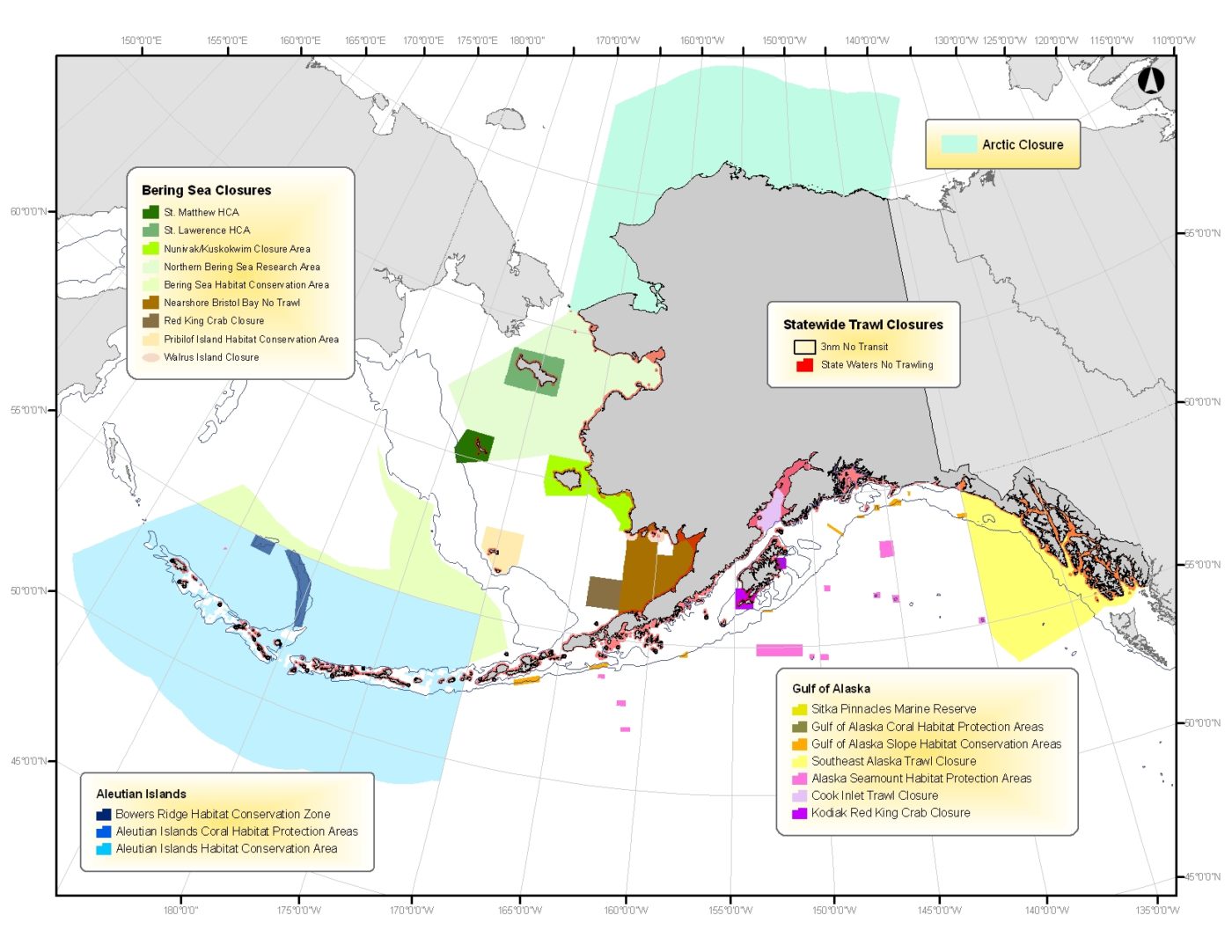Ocean habitat is essential for maintaining productivity of fishery resources, and is a key component of an ecosystem-oriented management approach. Habitat that provides structural relief on an otherwise featureless bottom can be particularly important to fish for food, reproduction, and shelter from predators.
Structural habitat includes boulders, corals, anemones, kelp, and other living organisms attached to the ocean bottom. Because fishing gear has the potential to disturb structural habitat, regulations have been implemented to protect areas where this habitat type is known to occur. Vast areas of the North Pacific have been permanently closed to groundfish trawling and scallop dredging to reduce potential adverse impacts on sensitive habitat and to protect benthic invertebrates. These marine protected areas comprise a relatively large portion of the continental shelf, and in many respects, serve as marine reserves. In addition, fishery closures established in nearshore areas to reduce interactions with Steller sea lions have ancillary benefits of reducing habitat impacts as well.
All fishery management plans include a description and identification of essential fish habitat, adverse impacts, and actions to conserve and enhance habitat. Maps of essential fish habitat areas are useful for understanding potential effects of proposed development and other activities.
Staff Contact is Anita Kroska: 907-271-2805

Aleutian Islands
In February 2005, the Council adopted several new closure areas to conserve EFH. To minimize the effects of fishing on EFH, and more specifically to address concerns about the impacts of bottom trawling on benthic habitat (particularly on coral communities) in the Aleutian Islands, the Council took action to prohibit all bottom trawling in the Aleutians, except in small discrete “open” areas. Over 95% of the management area is closed to bottom trawling (277,100 nm2). Additionally, six Habitat Conservation Zones with especially high density coral and sponge habitat were closed to all bottom-contact fishing gear (longlines, pots, trawls). These “coral garden” areas, which total 110 nm2, are essentially marine reserves. To improve monitoring and enforcement of the Aleutian Island closures, a vessel monitoring system is required for all fishing vessels in the Aleutian management area.
Additionally, the Council adopted several new HAPCs. The Alaska Seamount Habitat Protection Area encompasses all 16 seamounts in Federal waters off Alaska, named on NOAA charts, of which one occurs in the Aleutian Islands (Bowers). Bottom-contact fishing is prohibited in this HAPC. The Aleutian Islands Coral Habitat Protection Area designates six areas where submersible observations of high density coral have been made. All bottom-contact gear (longlines, trawls, pots, dinglebar gear, etc.) is prohibited in these areas. Additionally, the relatively unexplored Bowers Ridge is also identified as a HAPC. As a precautionary measure, the Council prohibited mobile fishing gear that contacts the bottom within this 5,286 nm2 area.
Bering Sea
In June 2007, the Council adopted precautionary measures to conserve benthic fish habitat in the Bering Sea by “freezing the footprint” of bottom trawling by limiting trawl effort only to those areas more recently trawled. Implemented in 2008, the new measures prohibit bottom trawling in a deep slope and basin area (47,000 nm2), and three habitat conservation areas around St Matthew Island, St Lawrence Island, and an area encompassing Nunivak Island-Etolin Strait-Kuskokwim Bay. The Council also established the Northern Bering Sea Research Area that includes the shelf waters to the north of St. Matthew Island (85,000 nm2). The entire Northern Bering Sea Research Area will be closed to bottom trawling while a research plan is developed.
Gulf of Alaska
Also in February 2005, bottom trawling for all groundfish species was prohibited in 10 designated areas along the continental shelf of the Gulf of Alaska. The GOA Slope Habitat Conservation Areas, which are thought to contain high relief bottom and coral communities, total 2,086 nm2.
Additionally, the Council adopted several new HAPCs. The Alaska Seamount Habitat Protection Area encompasses all 16 seamounts in Federal waters off Alaska, named on NOAA charts, fifteen of which are in the Gulf of Alaska (Brown, Chirkikof, Marchand, Dall, Denson, Derickson, Dickins, Giacomini, Kodiak, Odessey, Patton, Quinn, Sirius, Unimak, and Welker). Bottom-contact fishing is prohibited in all of these HAPCs, an area which totals 5,329 nm2.
In Southeast Alaska, three sites with large aggregations (“thickets”) of long-lived Primnoa coral are also identified as HAPCs. These sites, in the vicinity of Cape Ommaney and Fairweather grounds, total 67 nm2. The Gulf of Alaska Coral Habitat Protection Area designates five zones within these sites where submersible observations have been made, totaling 13.5 nm2. All bottom-contact gear (longlines, trawls, pots, dinglebar gear, etc.) is prohibited in this area.
Arctic
In 2009, an Arctic Fisheries Management Plan was implemented. The plan covers the Arctic waters of the United States in the Chukchi and Beaufort seas. Warming ocean temperatures, migrating fish stocks and shifting sea ice conditions from a changing climate may potentially favor the development of commercial fisheries. The plan establishes a framework for sustainably managing Arctic marine resources. It initially prohibits commercial fishing in the Arctic waters of the region until more information is available to support sustainable fisheries management (an area roughly 150,000 sq nm2).




